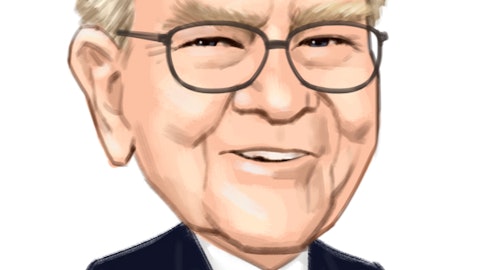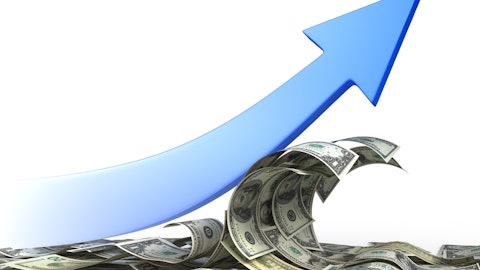Archer Daniels Midland Company (NYSE:ADM)
This leading agriculture company is another security that I’d classify as a “low bar” type of investment. In fiscal year 2014 the company earned around $3.40 per share and it’s “only” expected to generate $2.50 or so per share this year; as such, the share price is now 23% lower than it had been.
Yet you still have a company that is paying out less than half of its earnings in cash, with a strong commitment toward both dividends and share repurchases. The starting yield is around 3.2%, which has been a common theme so far. Over the past decade the average yield has been closer to 2% instead of 3%. Granted part of this is a result of an increased payout ratio, but part of it comes from the lower share price and higher dividend payments (a 7% increase this year).
Although the company is a Dividend Aristocrat – having paid an uninterrupted dividend for 84 years and increased it for the last 41 years – a 2% yield just doesn’t grab your attention like a 3% might. Archer-Daniels-Midland stock looks more appealing now than in the past.
The question that you have to ask yourself is whether or not the business is now 20%+ worse off. In the short-term certainly the lower earnings reflect this, in the long-term it’s not as clear as people continue to eat and demand the products created by Archer-Daniels-Midland’s crops.
Archer Daniels Midland Company (NYSE:ADM)’s combination of an above-average yield, value, and favorable long-term growth prospects make it a current favorite of The 8 Rules of Dividend Investing.
Follow Archer-Daniels-Midland Co (NYSE:ADM)
Follow Archer-Daniels-Midland Co (NYSE:ADM)
CSX Corporation (NASDAQ:CSX)
The story here is quite similar to Union Pacific, as detailed above. Granted not perfectly comparable – Union Pacific is a westward railroad, while CSX operates on the eastern half the of U.S. You have the positives – a monopoly-like business from a well-established firm – with the negatives – high capital outlays and general cyclicality.
CSX’s results in particular have been weighed down by a dramatic decline in coal volumes. Just a year ago the midpoint estimate for earnings during 2016 were expected to be about 28% higher than they were in 2014. Today, the estimates have come all the way down to being flat or even representing a slight decline. So certainly there are concerns and short-term earnings pressure.
Yet once again, I find that creating a “lesser” scenario can help illuminate whether or not the current value proposition is interesting. Incidentally, I just recently provided a look at what a “no growth” investment in CSX Corporation (NASDAQ:CSX) could look over the next decade. Basically if the company earns the same amount as it had – $1.8 billion annually – and pays out 75% or so of its profits as dividend and share repurchases, investors could anticipate 4% to 6% gains.
That may not sound especially compelling, but remember this assumes zero growth from this point forward.
If the company is able to generate a bit of growth, 5% annualized gains could easily turn into double-digit results. Which, incidentally, is actually reasonably below the spectacular results of the investment in the past decade.
Follow Csx Corp (NYSE:CSX)
Follow Csx Corp (NYSE:CSX)
American Express Company (NYSE:AXP)
There’s a common theme here. Excellent businesses with short-term concerns. Of course short-term concerns can become long-term issues, but for the moment all of the companies mentioned above are still generating substantial profits.
The “concerns” for American Express are real…
The company recently lost its partnership with Costco Wholesale Corporation (NASDAQ:COST) and there’s the possibility for more losses to come. Moreover, the company’s competitors are very present.
In the last year American Expresses’ share price is down about 20% and its down 35% since its peak in 2014.
Incidentally, there’s a bit of precedent for this: the last two times the share price was cut in half investors did quite well. Naturally that doesn’t mean that it has to work out this time, but it does give a bit of solace to the idea that much lower share prices are often opportunities for investment when you’re dealing with strong companies.
Even with the current hiccups the company is still expected to generate $5 billion annually. I think that’s an easy thing to forget if you’re just looking at the stock price. People see the share price drop by 20%, and it’s easy to project this image out into the future. Yet a share of stock represents an honest claim on the underlying profits of the business.
Here as well I have completed a “no growth” scenario, and once more the results are reasonable. The company’s dividend yield isn’t quite as high as some of the other securities mentioned, but the current payout ratio only makes up about a fifth of the total profits.
Even better is that American Express as not capital intensive in the way that a railroad is, so that leaves ample room for substantial share repurchases.
If American Express Company (NYSE:AXP) could generate just over $5 billion annually for the next decade and pay out roughly 60% of its profits as dividends and share repurchases, investors could see annual returns on the magnitude of 5% to 7% annually. And remember, that’s without the business getting better at all.
From 2005 to 2015 American Express went from earning $3 billion to $5 billion. This assumes that the company doesn’t improve for the next 10 years.
Follow American Express Co (NYSE:AXP)
Follow American Express Co (NYSE:AXP)





